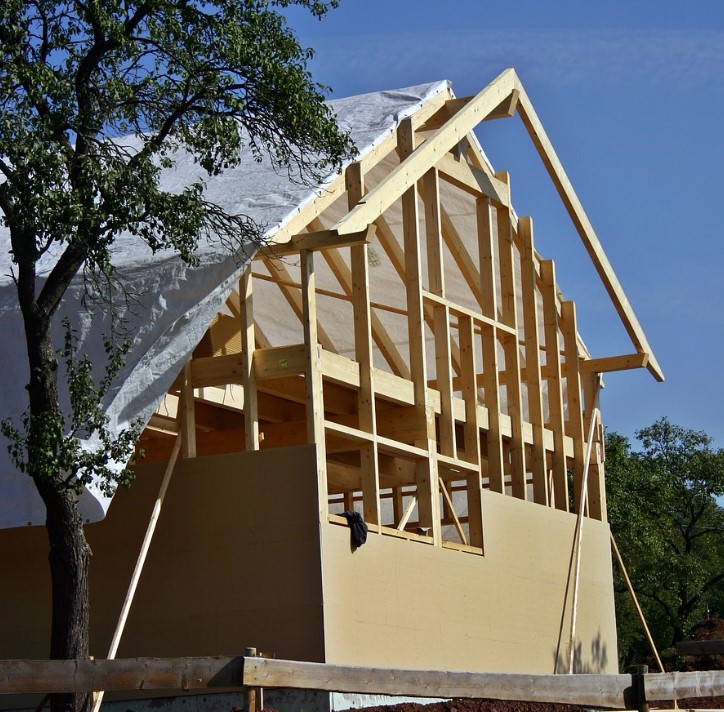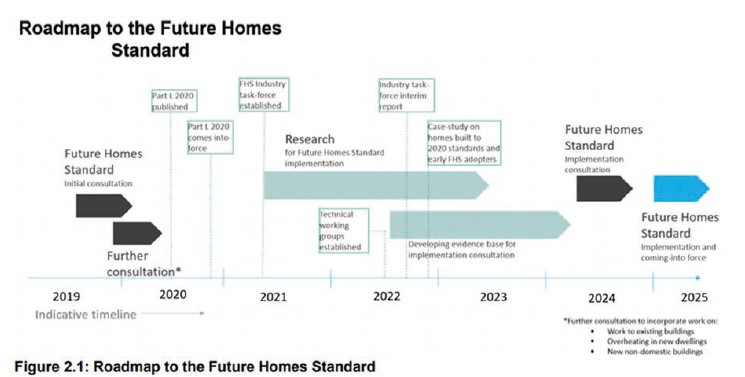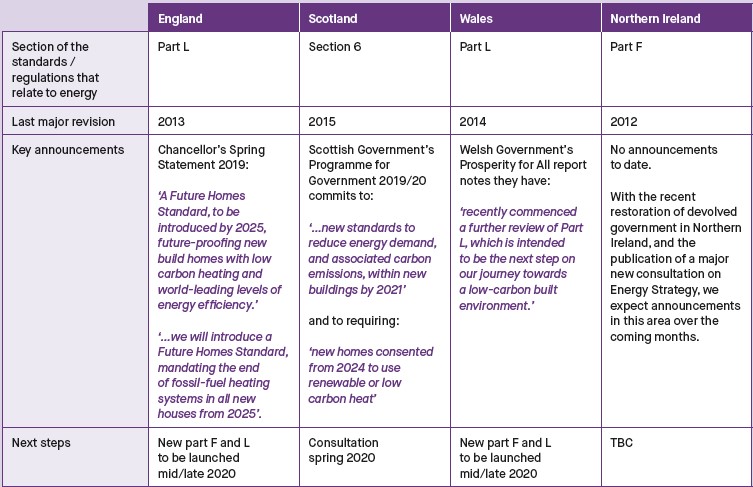Home design prospects under the Future Homes Standard
Contents |
[edit] Introduction
In June 2019, one of the last acts of Prime Minister Theresa May, was to commit the UK to net zero emissions by 2050. This made the UK the first major economy and member of the G7 group to legislate for net zero carbon emissions and pass the target into law, but how do we stop this from being another ‘Zero Carbon Homes’ debacle?
[edit] The end of Zero Carbon Homes
The reported cost of scrapping the Zero Carbon Homes by 2016 initiative is said to have cost the homeowner an additional £2bn in wasted energy in the period 2016–20 not to mention the impact it had on the UK’s carbon footprint.
The vehicle charged to deliver these targets is the Future Homes Standard (FHS). The FHS proposes that from 2025 all new homes will have world-leading levels of energy efficiency, in terms of performance, incorporating low-carbon heating systems and be totally detached from the gas network.
As we prepare for this, the first stage of implementation will be the uplift to standards in Part F and Part L of the building regulations for new dwellings in England. Following the launch of Ministry of Housing, Communities & Local Government's first consultation, there is now the opportunity for review of the proposed changes to look at what impact they will have on how we design and how industry can drive the change to ensure we get the Future Homes Standard right.
[edit] Proposals
Homes are a significant contributor to greenhouse gas emissions in the UK, responsible for 15% of our total emissions in 2018. However, what is slightly more alarming is that unlike other sectors, emission levels from residential homes actually rose from 2017 to 2018.
The proposed changes to the building regulations for England suggests that a reduction in carbon emissions from new housing will be achieved via one of two options:
[edit] Option 1 - ‘Future Homes Fabric’
This would achieve a 20% reduction in CO2 from new dwellings compared to the current standards. This performance standard is based on the energy and carbon performance of a home with:
- Very high fabric standards to minimise heat loss from windows, walls, floors and roofs (typically with triple glazing).
- A gas boiler.
- A waste water heat recovery system.
[edit] Option 2 - ‘Fabric plus technology’
This would be a 31% reduction in CO2 from new dwellings compared to the current standards. This option is likely to encourage the use of low-carbon heating and/or renewables. The performance standard is based on the energy and carbon performance of a home with:
- An increase in fabric standards (but not as high an increase as in Option 1, likely to have double rather than triple glazing).
- A gas boiler.
- A waste water heat recovery system.
- Photovoltaic panels.
[edit] Analysis of options
At first glance, both options look like viable proposals, with the Government preferring option 2 due to its initial projected monetary savings. It is however the method in which the new regulations will look at the energy efficiency and fabric of a home that may provide cause for concern.
Under the current Part L 2013, the Fabric Energy Efficiency Standard (FEES) metric sets the benchmark for a building through its ‘notional building’ and minimum u-values for fabric standards. This helps new homes retain relatively ‘good’ levels of thermal competence and has always been seen as a useful benchmark for thermal design.
Although the proposed Part L 2020 sets out new and improved minimum fabric standards, which is welcomed, the use of the FEES target has been removed, thus resulting in the potential for new homes to be designed and built with poor energy consumption whilst being offset with healthy reductions of CO2 emissions.
Some might question whether the 2020 targets are ambitious enough. Should we be driving a fabric first approach in order that we are designing our homes as energy efficiently as possible in order to eradicate the need for expensive retrofitting when more stringent regulations are introduced in the future?
Another proposal within the FHS is to remove the ability of local authorities to demand higher energy efficiency standards than those set out in Part L. (For instance, the London plan currently sets carbon emissions for new homes 35% lower than Part L.) This could have implications for localised energy reduction targets.
Currently, 65% of local authorities across the UK have declared a climate emergency and set their own unique planning targets. It is understood that local authorities tend to be much better placed to assess local need and viability. Restricting the ability of local planning authorities to set higher energy efficiency or zero carbon standards on their own seems at odds with the overall direction of policy on decarbonisation and localism.
Also targeted is the tightening up of transitional arrangements for housebuilders to navigate building regulations approval. At present, housebuilders can build homes to the regulations in force when they started work on a development, even if updated regulations are introduced before it is finished. The consultation proposes that all new homes must meet the new regulations when introduced.
[edit] Rest of the UK
Whilst we are focussing on England, the rest of the UK are also committed to start delivering on net zero 2050.
Overall, the consultation is a big step in the right direction for England, providing two viable routes for 2020 whilst encouraging renewable technologies to develop. The scene has now been set for developing the 2025 Future Homes Standard.
To deliver 2025 FHS and net zero by 2050, and to keep up with other nations' developments, it is probable that the UK will need to take greater steps in the not too distant future. The specification and regulation landscape is moving quickly and needs to be constantly reviewed to minimise technical, operational and financial impacts on the construction of new homes. The England consultation is now closed.
This article originally appeared under the headline, 'Future Homes Standards – What does the future look like for the design of new homes?' in the Architectural Technology Journal (at) issue 134 published by CIAT in Summer 2020. It was written by Steven Hedley MCIAT, Vice-President Technical.
--CIAT
[edit] Related articles on Designing Buildings Wiki
- A zero-carbon UK by 2050?
- CIAT articles.
- Fabric Energy Efficiency Standard FEES.
- Future Buildings Standard shortcomings raised.
- Future Homes Standards.
- Green Housing Revolution.
- Homeowner
- National Design Guide.
- Net zero carbon 2050.
- U-values.
- Zero carbon homes.
[edit] External resources
Featured articles and news
RTPI leader to become new CIOB Chief Executive Officer
Dr Victoria Hills MRTPI, FICE to take over after Caroline Gumble’s departure.
Social and affordable housing, a long term plan for delivery
The “Delivering a Decade of Renewal for Social and Affordable Housing” strategy sets out future path.
A change to adoptive architecture
Effects of global weather warming on architectural detailing, material choice and human interaction.
The proposed publicly owned and backed subsidiary of Homes England, to facilitate new homes.
How big is the problem and what can we do to mitigate the effects?
Overheating guidance and tools for building designers
A number of cool guides to help with the heat.
The UK's Modern Industrial Strategy: A 10 year plan
Previous consultation criticism, current key elements and general support with some persisting reservations.
Building Safety Regulator reforms
New roles, new staff and a new fast track service pave the way for a single construction regulator.
Architectural Technologist CPDs and Communications
CIAT CPD… and how you can do it!
Cooling centres and cool spaces
Managing extreme heat in cities by directing the public to places for heat stress relief and water sources.
Winter gardens: A brief history and warm variations
Extending the season with glass in different forms and terms.
Restoring Great Yarmouth's Winter Gardens
Transforming one of the least sustainable constructions imaginable.
Construction Skills Mission Board launch sector drive
Newly formed government and industry collaboration set strategy for recruiting an additional 100,000 construction workers a year.
New Architects Code comes into effect in September 2025
ARB Architects Code of Conduct and Practice available with ongoing consultation regarding guidance.
Welsh Skills Body (Medr) launches ambitious plan
The new skills body brings together funding and regulation of tertiary education and research for the devolved nation.
Paul Gandy FCIOB announced as next CIOB President
Former Tilbury Douglas CEO takes helm.
UK Infrastructure: A 10 Year Strategy. In brief with reactions
With the National Infrastructure and Service Transformation Authority (NISTA).


























